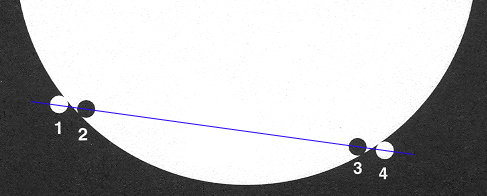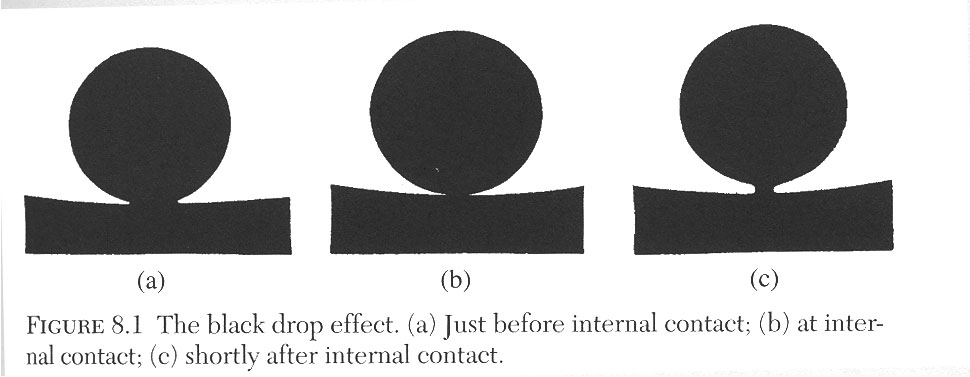
For the calulation of the distance to the Sun precise geographical coordinates of the observing site are needed, from where the measured contact time of venus stem. For this reason you will have to determine the latitude and longitude of your observing site.
This coordinates can e.g. be derived from an accurate map. More precise data can be obtained, using a gps-receiver, which is positioned at your location. Alternatively the website http://www.heavens-above.com/ may be helpfull.
The contact times, measured on different continents, are only comparable if they are converted from the time of the local time zone to "Coordinated Universal Time (UTC)". On the day of the transit one should be able to perform this conversion promptly. It therefore should be practiced before. The conversion becomes unnecessary if a watch is used, which has been set to universal time.
The current universal time can continuously be obtained e. g. from the website http://www.heavens-above.com/.
One safe methode to observe the transit of Venus is the method of projection. The instrument needed is either a good pair of binoculars or a telescope. Additionally you need a white screen.

The instrument has to be mounted on a tripod. If it is directed towards the Sun, then an image of the Sun can be caugth on the screen behind the eye-piece. (Never look directly through the instrument into the Sun !!!! This can damage your eye. Additional warning: Be careful with the second tube of a binocular!). If a proper distance of the screen has been found, where the projected image of the Sun is as large as possible and the contrast of the image is still sufficient, then the screen should be mounted to the instrument in this position with a bracket. While tracking the instrument to the Suns position, the screen will then be always on the right place.
Only with a special solar filter, mounted to the front end of the telescope's tube, the Sun can be observed directly through the telescope. Suitable are telescopes offering 30 times magnification power or higher. Presumably this direct method of observation will yield more accurate contact times as compared to the projection method.
Because the measurement of contact times should be exact to seconds, a precise watch has to be used. For this purpose a radio controlled clock is very recommendable. Or, even better, use the internet for this purpose. If an other watch is used, it should be set to the time signal of broadcasting or television stations on the day of the transit.

There are locations on the Earth from where only a part of the transit of Venus can be observed. Therefore there are countries from where observers can only watch the ingress of Venus into the Sun's disk and other countries from where only the egress can be observed. The entire transit can only be seen by observers which are located within a limited sector on the Earth surface.
For the suggested method it will be sufficient if only one of the contacts of Venus with the Sun's limb, which are shown in the above diagramm, can be observed. (Afterwards the evaluation needs a reference value of the same kind of contact from a different location).
Most difficult will be the determination of the first contact time in postion 1 (external ingress), because Venus becomes visible if it has propagated already a little into the Sun's disk. We therefore suggest to concentrate your measurements on the determination of the contact times of the positions 2, 3 and, perhaps, 4.

From the history of science it is known, that the determination of the contact times for the internal ingress (position 2) and the internal egress (position 3) was disturbed by the so called "black drop effect". There where Venus touched the Sun's inner limb, a drop like deformation was observed that made it difficult to judge about the exact moment of contact. You should try anyway to determine the contact time as exact as possible.
For the exchange of your measuring data with all other participating schools in this project, you will find an "Input mask for the contact time method" within the folder "measuring data" which is located in the "Forum" of the contact time method. Because of technical reasons it is only possible to submit the contact time of each of the four positions separately. If you send us your data by pressing the "submit" button, they will be transmitted via internet to a data base. From there they become published in a list, which you will find in the same folder containing the input mask. Within this data pool you can search for suitable reference data, transmitted by all other participating schools.
The calculation of the distance to the Sun needs besides the measured contact time at your own observing site suitable reference data of an other observing site. When choosing reference data from the obove mentioned list, you should consider the following criteria:

Side of the Earth from which the ingress of Venus can be observed.

Side of the Earth from which the egress of Venus can be observed.
If suitable reference data have been obtained, the distance to the Sun can be evaluated. The necessary calculation can be done using the program "evaluation_contact_time.exe".